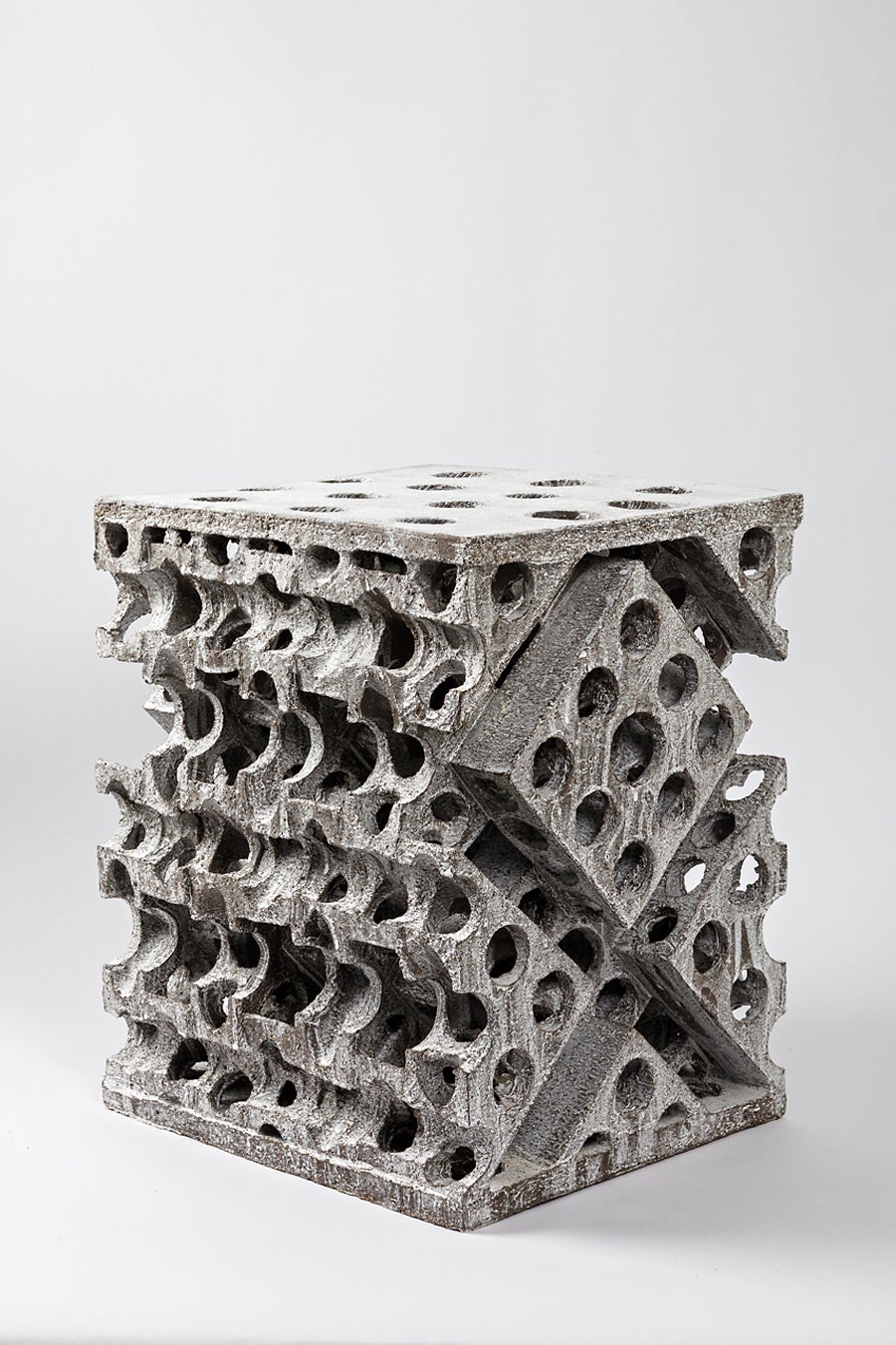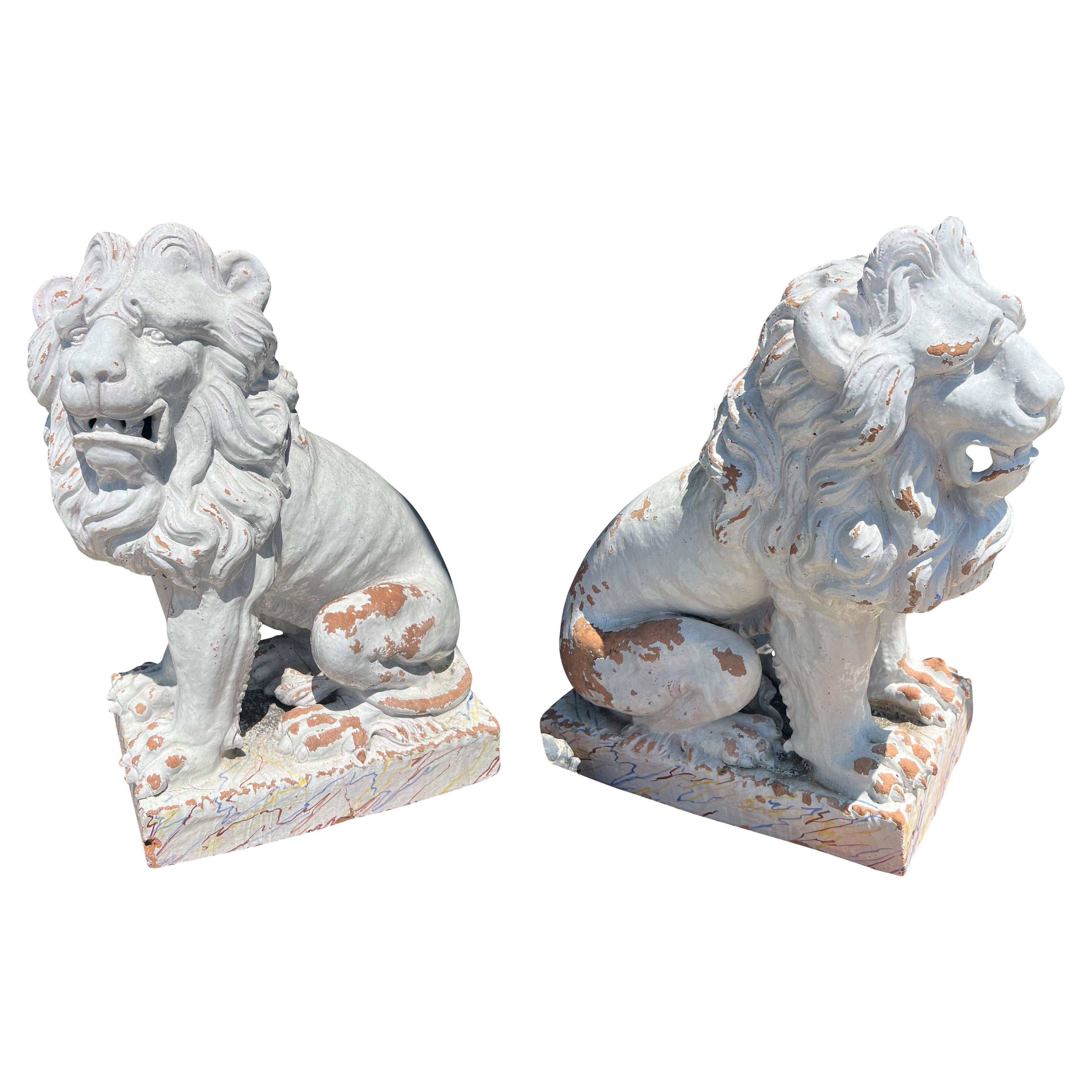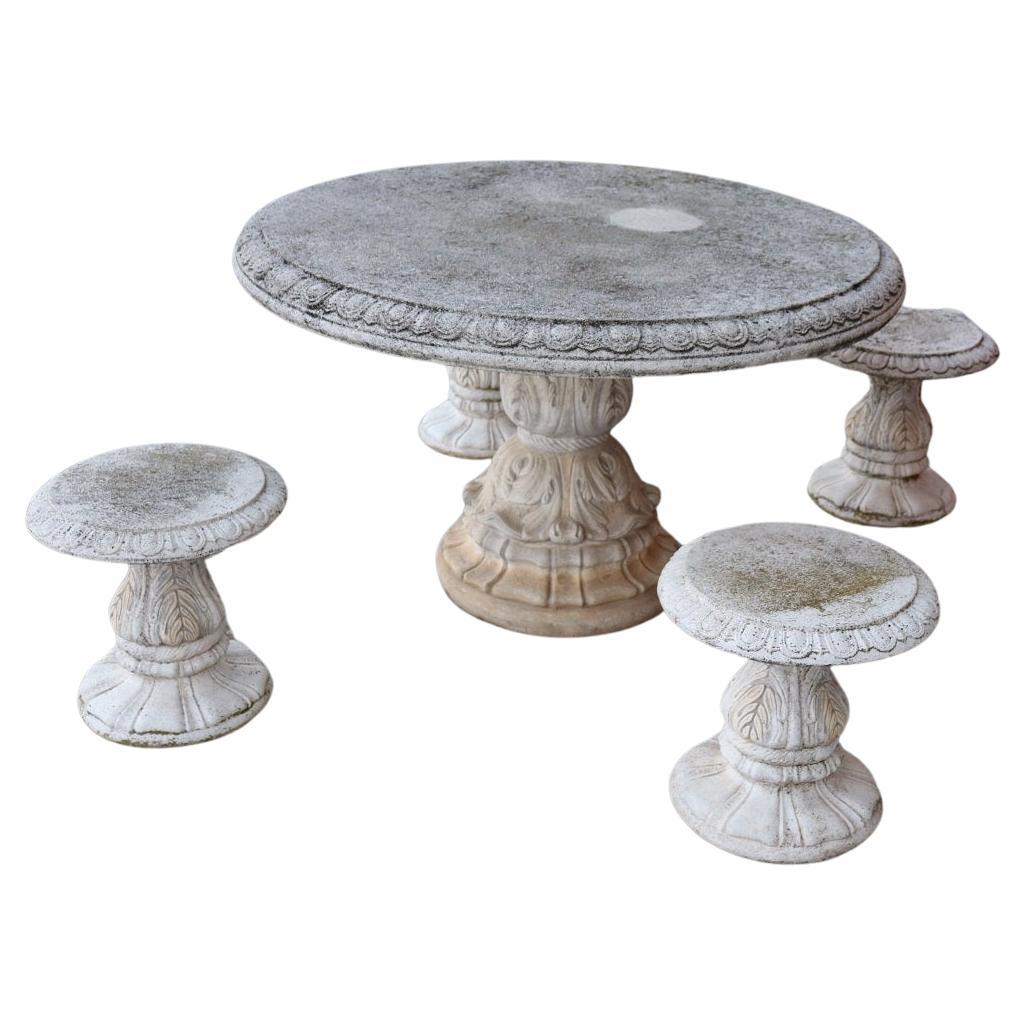Items Similar to Important Italian Renaissance Gardener
Want more images or videos?
Request additional images or videos from the seller
1 of 12
Important Italian Renaissance Gardener
About the Item
IMPORTANT ITALIAN RENAISSANCE GARDENER
ORIGIN: NORTHERN ITALY
PERIOD: 16th CENTURY
Height: 52 cm
Length: 130 cm
Depth: 53 cm
Verona marble
Taking the form of an antique sarcophagus, this architectural element is adorned with powerful and animated sculpted motifs. Supported by a base of powerful gadroons, it features a particularly expressive mask of a satyr with goat's horns on its main face. It is flanked by two symmetrical scrolls of acanthus leaves. These scrolls are inhabited by eagles with wide open beaks.
The sides each bear a decorative coat of arms. On the first is a griffin, while the second shows a small character with pointed ears, carrying a flowery basket on his head.
On the rear side a coat of arms (1. Lion rampant ; 2. Tree torn out) framed by stems and leaves, the end of which forms a winged lion with a leafy body.
The upper edge is underlined by a frieze of heart-shaped grapes.
- Dimensions:Height: 20.48 in (52 cm)Width: 51.19 in (130 cm)Depth: 20.87 in (53 cm)
- Materials and Techniques:
- Period:
- Date of Manufacture:16th Century
- Condition:Wear consistent with age and use. Minor losses. Minor structural damages. Minor fading.
- Seller Location:Saint-Ouen, FR
- Reference Number:1stDibs: LU3115336025362

About the Seller
5.0
Vetted Seller
These experienced sellers undergo a comprehensive evaluation by our team of in-house experts.
Established in 2016
1stDibs seller since 2017
153 sales on 1stDibs
Typical response time: 7 hours
- ShippingRetrieving quote...Ships From: Paris, France
- Return PolicyThis item cannot be returned.
More From This SellerView All
- Important and sober Italian Renaissance CredenzaLocated in Saint-Ouen, FRORIGIN : ITALY, VENICE PERIOD : 16th CENTURY Height: 103 cm Length: 174 cm Depth 45 cm Walnut Usual restoration The low sideboard with several doors became more common in the...Category
Antique 16th Century Italian Renaissance Credenzas
MaterialsWalnut
- Important French Renaissance ChestLocated in Saint-Ouen, FRIMPORTANT FRENCH RENAISSANCE CHEST ORIGIN : BURGUNDY, FRANCE PERIOD : 16th CENTURY, 2nd FRENCH RENAISSANCE Height: 85cm Length: 170cm Depth: 68cm Oak wood Good condition Original lock Chest is an essential item of Medieval and Renaissance furniture. With its handles it was conceived to be easily moved from one house to another. It would hold linens, dishes or jewellery. Chest was also the ideal wedding present and would enclose the bride’s trousseau. In the middle of the 16th century chests are decisively transformed, their conception now favouring architecture, sculpture and images. This oak wood chest shows impressive proportions with a solid frame. Large mullions are assembled with mortise and tenon joints also securing three carved panels. The facade lower part comprises a high plinth hiding the base of the jambs and acting as feet. It is carved with a frieze of canal motifs topped with palm leaves. The carved decor spreads over the facade of the chest and underlines its structure. On the mullions appears a vegetal decor including roses and palm leaves executed with rigorous symmetry. They frame three rectangular panels. The central one is enriched with two female sphinxes back to back. They wear helmets and spread their wings while their body is partially hidden by long leaves. In the centre a female mask is positioned over draperies. The two lateral panels show a similar but not identical decor. Indeed we can notice a few variations in the motifs. The left hand side panel is adorned with a cut-out leather upon which is depicted two extraordinary ram heads. Their bodies are intertwined with the leather and vegetal motifs in elegant scrolls. A large chou bourguignon stands between both heads. The panel is centred with another ram’s head carved in high relief. On the right hand side panel the composition is alike. The chou bourguignon has been replaced with a shell and the lower part of the panel is adorned with two large fully bloomed flowers. The chest is topped with a frieze of geometrical motifs including scrolls, ovals and rectangles. On the sides, the surface is divided in two moulded rectangular spaces adorned with frame-like scrolls, rectangular cartouches and palm leaves. The chest closes with a massive original lid that can be locked with a key. The important and abundant sculpted decor of this chest allows us to locate its conception in the Burgundy region, France. The regular composition is allied to a remarkable imaginative freedom in the execution of the figures. The very rich iconography draws from the art of Fontainebleau as well as Italian art. The Italian Wars have indeed favoured artistic exchanges and influences between France and the peninsula. The craze for Italian art, particularly during the reign of King François I...Category
Antique 16th Century Blanket Chests
MaterialsOak
- Important Italian Renaissance Polychrome Chest with Coat-of-ArmsLocated in Saint-Ouen, FRImportant Italian Renaissance Polychrome chest with coat-of-arms Origin: Italy Period: early 16th century Height: 71cm Length: 190cm Depth: ...Category
Antique 16th Century Renaissance Blanket Chests
MaterialsWood
- Rare and Important German Renaissance ChestLocated in Saint-Ouen, FROakwood Original lock and key This beautiful and robust chest stands on square feet ending in flattened buns. The base presents plain mouldings. The facade is divided in four panel...Category
Antique 16th Century German Renaissance Blanket Chests
MaterialsWood, Walnut
- Important Renaissance Cabinet from Lyon 'France' with a Decor of PerspectivesLocated in Saint-Ouen, FRAs soon as 1540 France's second Renaissance is in the making, intimately linked to the rediscovery of the Antique world. The development of the printing and engraving industry allows the spread of artworks and models in many cities and countries. The Italian influence can be perceived in every artistic field. While the French king entrust the most talented Italian artists with major projects such as Il Rosso or Primaticcio in Fontainebleau, French artists also travel to Italy to form themselves to this new style. In Italy they get acquainted with the work of Leo Battista Alberti the first to theorize perspective (De Pictura, 1435-36) and architecture (De re oedificatoria, 1541). Those two publications would have a revolutionary impact on arts. Furniture is marked by the work of the most famous Italian architects of the time as well as French architects. Indeed Philibert de l'Orme competes with Alberti and by the end of his life publishes several treaties including one devoted to a theory of architecture (1567). Unfortunately he would not live to complete the second volume. In this treaty he expresses his interest for mathematical norms applied to architecture, copied from the Antique. His journeys in Italy allowed him to accumulate the most sophisticated references. Jean Bullant, another architect of great talent also theorizes his practice. He establishes rules characterizing Greco-Roman art staying faithful to Vitruvius. Following this new inspiration the structure of furniture evolves. From then on appear columns, capitals, cornices, friezes and architraves. The ornamentation uses this inspiration as well with egg-and-dart, palm leaf and rose adorning the most beautiful pieces. In Lyon, crossroad where meet merchants from everywhere those new experiments are welcomed. Lyon florishing printing industry allows the spreading of models and treaties essential to the artist's work. Thus the first publication of Vitruvius' De Architectura in France would be printed in Lyon in 1532. Artists from Lyon rediscover and familiarize themselves with the Antique knowledge very early. They adopt those new ideas and use them in their own creations. Lyon cabinet-makers re interpret Antique architecture and Italian Renaissance palaces to give their pieces a pure and harmonious architectural structure. Grooved pilasters are particularly favored. They are topped by capitals of diverse orders always respecting the sequencing with simpler ones for the lower levels and the richest ones on the higher levels. As for the ornamentation, one of the great distinctiveness of Lyon workshops remains the architectural perspective illusions, drawing inspiration from Tuscany. True masterpiece of the Second French Renaissance this important cabinet illustrates Lyon workshops' taste for fine Italian architecture inspired by Antiquity. An architectural perspective of great quality is treated in symmetry on each panel. This two-bodied cabinet without recess stands on four rectangular feet. The base comprises a molding, a palm leaf frieze and is bordered by a braid. The lower body is divided by three grooved pilasters with Tuscan capitals framing two door-leaves. The two panels are encircled by a moudled frame with palm leaves. They are finely carved with a decor of fantasized architecture depicting an Italian Renaissance palace erected symmetrically on each side of a grooved pilaster. On the ground floor a door opens through a stilted arch while the stories are opened with mullioned windows, dormers and occuli. Two large pegged-boss cladded pillars support the entablature enriched by a palm leaf frieze upon which stands an arch whose coffered intrados is centred by a rose. Behind this arch a pyramid appears, standing in front of a second facade with a window topped by a broken curvilinear pediment under a cul-de-four with a shell. The checker flooring gives depth to the low-reliefs creating vanishing points structuring the panels and guiding the eye of the observer. A thin laurel braid highlights the belt of the cabinet where are located two drawers. Their facades are adorned by palm leaves in hoops. The upper body is encircled with palm leaves. The same ternary division as in the lower body appears. However, the pilasters are topped by Ionic capitals with volutes and egg-and-dart. The door-leaves are framed with flowers. On the panels the artist has designed another architectural decor. On the foreground open two arches on top of grooved pilasters with rectangular capitals adorned with palm leaves. The arches are enriched with braids and the coffered intrados bears a decor of roses. The spandrels also bear a flower decor. In the background another arcature hosts a fluted grooved column topped with double basket acanthus capital, characteristic of Corinthian order. The triangular pediment is interrupted by a choux bourguignon. A large cornice crowns the cabinet. It stands on pilasters and forms an entablature comprising a palm leaf frieze and an egg-and-dart, triglyph and palm leaf cornice. The cabinet's sides have also been carefully considered. The lower body's panels are enriched with an arch rising above a broken pediment portico hosting a twisted column. Flowers garnish the spandrels. An architectural facade completes the decor. The upper body's panels present two arches supported by a facade opened with dormers and mullioned windows as well as cartouches (one bears the inscription 1580 dating the cabinet) suggesting the interior of an Italian Renaissance palace, confirmed by the chandeliers. The flooring leads our gaze to a second arch with a broken curvilinear pediment where stands a flower vase. This arch opens onto a perspective of another facade along a road. Inside the cabinet, on the lower body door-leaves appear two designs. On the right door is depicted a Crucifixion. Saint Mary and Saint John flank the Christ on the cross. In the bottom part is inscribed « Dure uiator abis nihil haec spectacula curas / Pendenti cum sis unica cura Deo. / Tota suo moriente dolet natura Magistro. / Nil qui solus eras caussa dolenda doles. ». The signature [Christoff Swartz Monachiensis pinx[it] / Ioa[nnes] Sadeler sculp[it]] tells us it was made by Johan Sadeler I (1550-1600) after Christoph Schwartz (1548-1592). This engraving belongs to an ensemble depicting the Passion of Christ Johan Sadeler executed in 1589 after an altar piece painted by Christoph Schwartz for the private chapel of Renée of Loraine, wife of Duke William V of Bavaria. This altar piece made of nine copper panels has been destroyed during the 19th century. The Crucifixion panel once in the centre of the altar piece is the only one that survived and is today kept in Munich's Alte Pinakothek. On the left door appears Saint Francis receiving the stigmata. The inscription says : « Signastidomine Servum Tuum. Franciscum. Signis Redemptionis Nostrae ». This Renaissance cabinet with an architectural decor appearing as much in the structure faithful to Antique rules...Category
Antique 16th Century European Renaissance Cabinets
MaterialsWalnut
- Exceptional Italian Renaissance "Cassone"Located in Saint-Ouen, FRExceptional Italian Renaissance « Cassone » Origine : Italy, Florence or Siena Period : Late 15th Century Measures: Height: 63 cm Length: 1...Category
Antique 15th Century and Earlier Blanket Chests
MaterialsWalnut
You May Also Like
- Blue Important Abstract Ceramic Sculpture by F Michel Garden Decorative DesignLocated in Neuilly-en- sancerre, FRFrancine Michel Large and elegant blue ceramic sculpture by Belgian artist Realised in France in La Borne, circa 2010 Ceramic sculpture for indoors and outdoors Sculpture...Category
21st Century and Contemporary French Modern Abstract Sculptures
MaterialsCeramic
- China Important Carved Stone "Penjing" Garden Table, Qing Dynasty ‘1644-1911’Located in South Burlington, VTChina, a carved antique stone Penjing or painting form garden table, middle Qing dynasty (1644-1911), limestone, three pieces Dimensions: 34 inches high and 55 inches long and 16 in...Category
Antique Early 19th Century Chinese Qing Sculptures and Carvings
MaterialsLimestone
- Pair Of Italian Majolica Garden LionsLocated in Essex, MAEach seated with stylized faux marble bases. From a Palm Beach Florida Estate.Category
Antique Late 19th Century Italian Garden Ornaments
MaterialsPottery
- Italian Renaissance Style Wrought Iron Wishing Stone Well HeadLocated in Rome, ITA fine Italian carved limestone and wrought iron wishing well head from the Veneto area. Great decoration for your garden. It may also be used as a...Category
20th Century European Renaissance Fountains
MaterialsLimestone
- Italian Neoclassical Garden Table with Four StoolsLocated in Casale Monferrato, ITBeautiful refined garden set in neoclassical style, circa 1980s main material mixed with gravel and cement. Beautiful round table with four stools. Gorgeous carved decoration. The se...Category
Vintage 1980s Italian Patio and Garden Furniture
MaterialsCement
- Art Deco Glazed Terracotta Italian Garden SculptureLocated in Douglas Manor, NYItalian made vintage cerulean blue terracotta Deco style female figure sculpture.Category
Vintage 1930s Figurative Sculptures
MaterialsTerracotta
Recently Viewed
View AllMore Ways To Browse
Austin And Seeley
Antique Weed Cutter
Cosanti Wind Chimes
Retro Garden Gnome
Vintage Bunny Ornament
Vintage Dovecote
Vintage Pig Ornaments
Vintage Pug Ornaments
Antique Wrought Iron Arbor
Artemis Mytilene
Concrete Bunny
Concrete Garden Orbs
French Cast Iron Bird Bath
Garden Arbours
Garden Gazing Ball
Hay Feeder
Hoodoo Stacks
Jockey Lawn Ornaments





